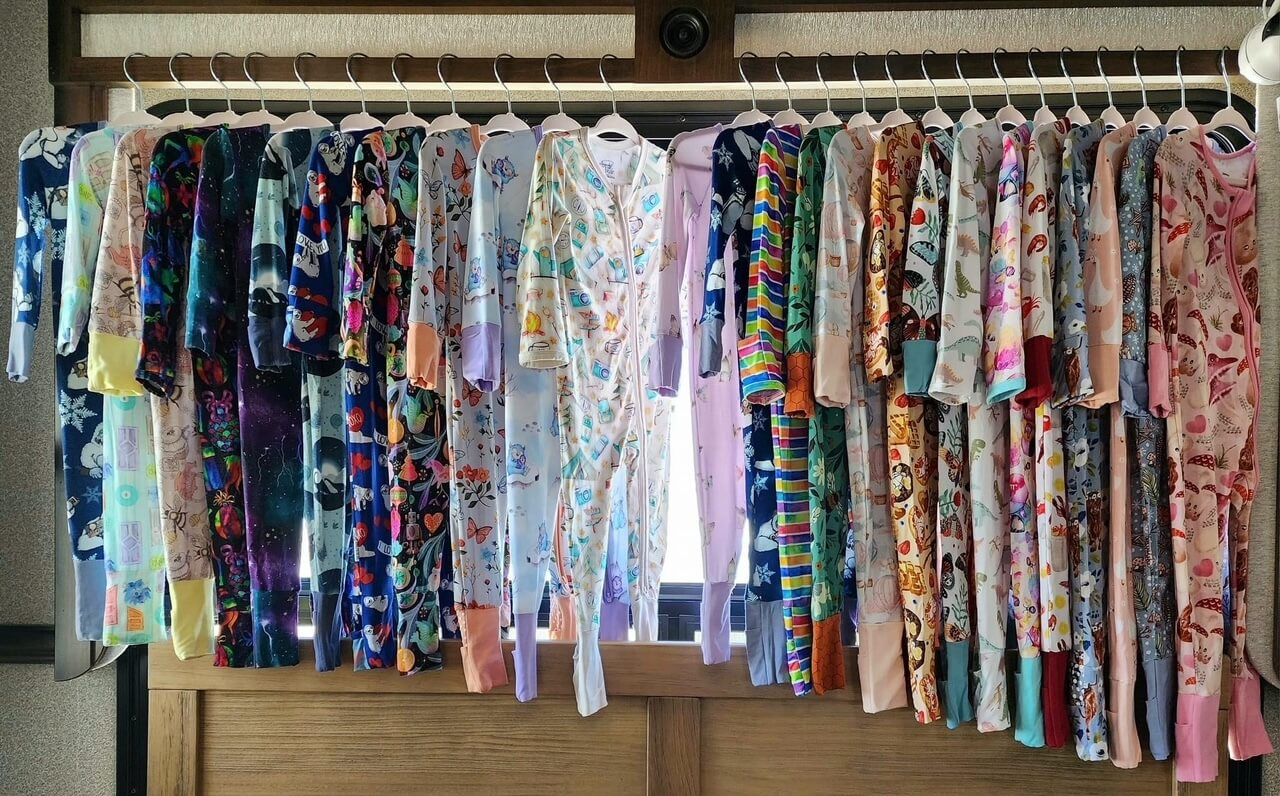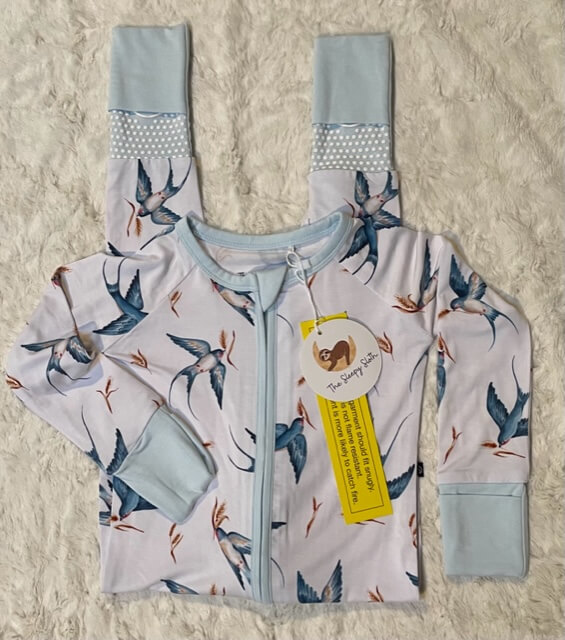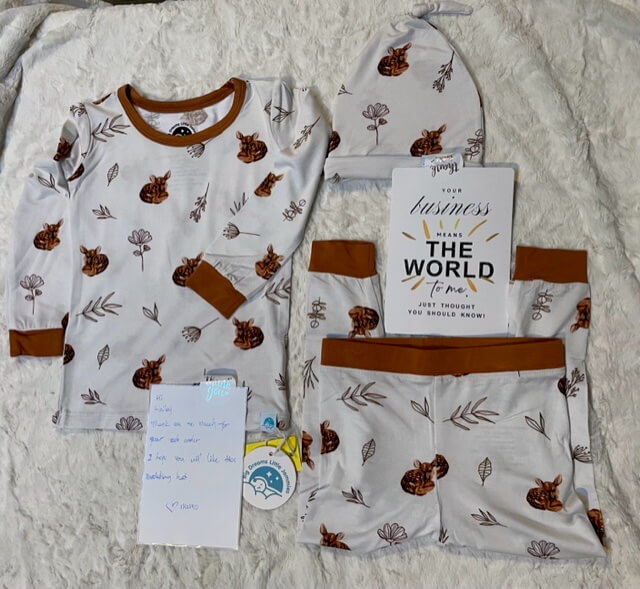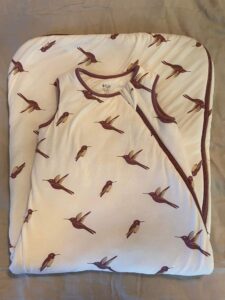What mama doesn’t want the best clothing for their baby’s delicate skin? If so, then bamboo is the way to go!

Bamboo baby clothing is an eco-friendly alternative when it comes to shopping for babies. They provide unmatched softness and breathability. Not only that but bamboo fabric has many natural qualities like anti-bacterial properties which make it a great choice for parents looking for their child’s comfort health & safety.
Read on to find out all you need to know about this unique material and its impact on the environment!
What Are The Benefits of Bamboo?
- Bamboo fabric has so many benefits. It is known for its remarkable softness, natural stretch, hypoallergenic properties, and breathability.
- It’s naturally insulating and highly absorbent, so it can keep your little one warm in the winter and cool in the summer. Bamboo fabric lightweight, breathable and thermal regulating, keeping your baby cool in summer weather.
- Bamboo is an eco-friendly choice. It is naturally antibacterial, and biodegradable – meaning no unnecessary harm to the environment during its production or disposal. It’s a renewable resource, making it an eco-friendly option for parents who want to reduce their carbon footprint.
- Bamboo fabric is four times more absorbent than cotton or other fabrics, so it’s great for cloth diapers.
Factors to consider when choosing the best bamboo baby clothes
- There are a variety of closure types available, including snaps and zippers.
- Most bamboo brands come in sizes premie/newborn to 3T (many even up to size 10!), making them versatile for different stages of development.
- They can be put in the washer or hand washed, but it’s recommended that they hang dry. Constant washings and drying can cause wash wear to develop faster. If you do put them in the dryer, they should tumble dry on the lowest heat setting that your dryer allows. Make sure no bulky items or items with velcro are in the dryer, as these can compromise your bamboo clothes.
How Is Bamboo Fabric Made?
Bamboo clothing is made from bamboo fiber, which is derived from the pulp of the bamboo plant. There are two main methods used to produce bamboo fiber: mechanical and chemical.
Mechanical Processing
Mechanical processing involves crushing the bamboo stalks and using natural enzymes to break down the bamboo into fibers, which are then washed and spun into yarn. This method is less commonly used because it requires a lot of energy and time, and the resulting fibers are rougher and less uniform.
Chemical Processing
Chemical processing, on the other hand, involves using chemicals to break down the bamboo into a pulp. The pulp is then forced through small openings to create fibers, which are then washed and spun into yarn. This method is more efficient and produces softer and more uniform fibers, but it does require the use of chemicals.
One popular form of bamboo fabric made using chemical processing is bamboo rayon, also known as bamboo viscose. Bamboo rayon is soft, silky, and lightweight, making it a popular choice for clothing.
Another type is bamboo linen, which is made by mechanically processing the fibers. Bamboo linen has a natural, rustic look and is often used for home furnishings since it’s more durable.
Caring for Bamboo Clothes
Avoid using hot water or high heat settings when washing or drying, as this can shrink or damage the fibers.
Use lukewarm water and mild detergent and choose a gentle or regular wash cycle.
You can use a vinegar rinse to enhance the softness and reduce static, but fabric softeners aren’t recommended.
Hang dry or use a low heat setting in your dryer. Avoid ironing or bleaching.
Stain removal tips
Accidents happen, and babies are prone to drooling, spilling, and blowouts. If you need to remove stains from an item, you can try some specific remedies that won’t harm their fibers or colors.
Some stain-fighting tips/suggestions:
- Mix baking soda and water into a paste and apply it to the stain for a few minutes, then rinse with cold water.
- Use white vinegar, hydrogen peroxide, or lemon juice on the affected area and let it sit for a few hours before rinsing. Always test the stain remover on a small area of the clothes first to see if it causes any discoloration or damage.
- For white bamboo, a little lemon juice and sunlight work wonders! I also like OxyClean White Revive, but I do notice that it affects the softness, so I only use it when absolutely necessary.
- Puracy is a must-have stain remover! If you can catch the stain before it becomes a stain (when you watch in slow-mo and that grape juice slips from their hands), that’s even better!
Common Misconceptions
Despite its increasing popularity and benefits, bamboo baby clothes are still subject to some misconceptions and myths that might make parents hesitant to try them. Here are some of the most common ones and their explanations:
- Bamboo is chemically treated: Yes and no. Some manufacturers might use harsh chemicals in the manufacturing process, so make sure to buy from reputable brands that use eco-friendly and non-toxic methods. If it’s a great concern, there are ways to manufacture the bamboo fabric using a mechanical process rather than a chemical process .
- Bamboo is expensive: I mean, yes. But… while it might be pricier than some other baby clothing, (which can definitely add up if you have multiple babies or kids!), it’s also more durable and long-lasting. By investing in high-quality bamboo baby clothing, you’re contributing to a sustainable and ethical industry that cares for the environment and the workers involved in the production.
- Bamboo baby clothes are not durable: This is false, as bamboo fibers are stronger and more resilient than cotton or polyester, for instance. They can last for years with proper care and maintenance, and won’t lose their softness or color easily.
Top Brands for Bamboo Baby Clothes
It seems like a million bamboo brands popped up overnight, but honestly, I love it. There are so many great aspects of all the different companies, so make sure to check out a lot of them (though, beware of the addiction you might develop and guard your wallet). Each of the companies below offers a unique selection of bamboo clothing, and I love all of them for various reasons. When it comes to finding the ideal brand (is there really one??), there are tons of factors to consider such as price, quality, colors/designs, customer service, fit, and honestly… brand loyalty.
Here’s a more in-depth review on my top 8.5 brands you absolutely must try!



- Kyte Baby was my first intro to bamboo because so many moms in my due date Facebook group suggested their sleep sacks. From there, I was hooked. Their fit is my favorite thing about them, but I just think overall they are a solid choice. They have a great resell value because they have a huge Facebook following.

- Bubble Baby is a new company that will no doubt smash the bamboo market. Their quality, prints, customer service and involvement, and commitment to the environment are above all others. And they are just so so soft!
- The Sleepy Sloth is definitely among my favorite brands. Their bamboo is thicker than many, the quality is superb, and they run big, making their wearability last!
- Larkspur Baby Co. is a great option if you are on a budget- especially if they are on sale! They aren’t quite as stretchy as some other brands, but they have a good selection of prints and solids, so give them a try!
- Love, Eloise is another great brand to try! They also run slightly large, so they fit for a long time!
- Little Sleepies is by far one of the most popular brands out there, and they run very large. They have a large variety of prints, but they also have a huge following, so things often sell out fast.
- Big Dreams, Little Jammies are very lightweight, and a favorite of mine for the summer time. The owner is incredibly sweet, and customer service overall is incredible.
- I’m putting goumi on this list, and even though they are a cotton/bamboo blend, they are super soft and very durable. Because they are a cotton blend, they are thicker, and one of my go-tos in the winter.

Safety Standards for Baby Clothes
Bamboo-based baby clothes are becoming increasingly popular for their natural fabrics and soft feel, but stricter measures must be taken to guarantee that these items meet safety standards. Look for certifications like Oeko-Tex 100 for added assurance before making your purchase.
The bamboo baby clothes should meet the requirements of Product Class I, which is the most stringent class of Oeko-Tex 100. This means that the clothes must be tested for harmful substances and must be safe for infants and young children.
Frequently Asked Questions
- Does bamboo fabric help with eczema?
Yes! Bamboo garments have become increasingly popular for babies with sensitive skin due to the softness of the fabric and its breathability.
- How do I know if bamboo baby clothes are organic?
It can vary company to company. You can always contact the company directly for specific details on their manufacturing process.
- How should I wash and dry bamboo baby clothes?
Bamboo should be washed on cold, cool, or warm on the delicate cycle and hung dry. If you must put it in the dryer, use the cool setting on low, and make sure there are no bulky items or items with velcro in the dryer.
- Are bamboo baby clothes more expensive than other fabrics?
Bamboo definitely costs more than other options, but should be considered an investment that’s well worth it. Footies and rompers generally run $30-$35 each. High-quality brands usually last longer than standard options due to the stretchiness of the fabric, saving money in the long run! It also has a high resell value, especially well cared-for items, so join some BST Facebook groups!
I’d love to know what your favorite brands are! Drop them in the comments!

buy accounts facebook https://buy-ad-account.top
buy fb account https://buy-ad-accounts.click
buy fb ad account facebook ad account buy
площадка для продажи аккаунтов маркетплейсов аккаунтов
маркетплейс аккаунтов https://akkaunty-dlya-prodazhi.pro/
купить аккаунт https://online-akkaunty-magazin.xyz/
маркетплейс аккаунтов https://akkaunty-optom.live/
магазин аккаунтов akkaunt-magazin.online
продать аккаунт https://akkaunty-na-prodazhu.pro
you are in reality a just right webmaster. The web site loading pace is incredible. It seems that you’re doing any distinctive trick. Furthermore, The contents are masterwork. you’ve performed a wonderful job on this topic!
Account trading platform Account Purchase
Account Sale Website for Selling Accounts
продажа аккаунтов соцсетей гарантия при продаже аккаунтов
биржа аккаунтов магазин аккаунтов социальных сетей
купить аккаунт с прокачкой аккаунты с балансом
покупка аккаунтов продажа аккаунтов
продажа аккаунтов купить аккаунт с прокачкой
There are definitely plenty of particulars like that to take into consideration. That could be a great level to carry up. I supply the thoughts above as general inspiration but clearly there are questions just like the one you deliver up the place the most important factor shall be working in sincere good faith. I don?t know if greatest practices have emerged around things like that, however I am certain that your job is clearly identified as a good game. Both boys and girls feel the affect of just a second’s pleasure, for the remainder of their lives.
WONDERFUL Post.thanks for share..more wait .. …
Excellent blog right here! Also your website rather a lot up very fast! What host are you using? Can I am getting your associate link to your host? I wish my website loaded up as quickly as yours lol
You made some really good points on your post. Definitely worth bookmarking for revisiting. Also, visit my website 46N for content about Thai-Massage.